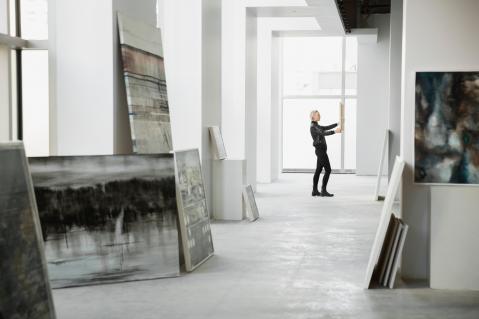With hesitant art buyers remaining unconvinced about buying art online, a Hiscox report finds out whether social media, price transparency and a wealth of background information are the answers.
In the four years that followed the financial crisis, growth in the art market surpassed even the most optimistic of forecasts. But nothing lasts forever. A report (external link) from UBS and Arts Economics points to an 11% slide in total sales last year. At $56.6bn, total sales value in the global art market are at a low not seen since 2012.
However, Hiscox Online Art Trade Report 2017 suggests a silver lining in the form of a growing online market. ‘For those who say the online art market has had its day – it hasn’t even had its morning yet, it’s still waking up,’ says Hiscox Head of Art and Private Clients Robert Read.
Unseen guarantee
According to the Hiscox report, established global brands in the art market such as Sotheby’s and Christie’s are starting to get to grips with the challenge of transforming their bricks-and-mortar model into multimedia businesses.
Yet despite the potential in the online art market, prospective art buyers remain cautious. Of all the issues cited by hesitant purchasers, none is more troubling than lack of physical inspection. According to the Hiscox report, 80% see it as the single biggest issue standing in the way of their next purchase.
With 80% of respondents also saying that the terms of guarantee were important in their decision to buy art sight-unseen, 71% added that having the option to insure the artwork would make them feel more confident about the purchase. The art world is waking up to these concerns: in stark contrast to five years ago, the default position among online dealers is to now extend a free, no-questions-asked returns policy. But will this be enough?
Social credibility
While customer reviews have not traditionally been a common feature of the art world, they’re vital for online purchases. According to the Hiscox report, 65% of hesitant art buyers said that customer reviews and feedback from previous clients were an important element of the art buying process.
While galleries have an important role to play in boosting the reputation of emerging and established artists, social media’s influence extends beyond reputation into creating communities. Likes, followers and friends on social media are helping to bridge the credibility gap. The channel of choice among art buyers in 2016 was Instagram, with 57% of galleries claiming it was the most effective in raising awareness.
Trust transparency
As more online tools become available, buyers can interrogate databases, share advice on the buying process and seek reassurances on price. This growing emphasis on transparency is beginning to break down concerns buyers may have about buying sight-unseen.
A startling 88% of online art buyers see the clear labelling of prices and the possibility to check past and comparable prices as crucial in what remains a notoriously opaque market. Independent valuation reports are helping to boost transparency, while publically available artist and gallery databases are beginning to address shared concerns about buying online.
New tools like the Magnus app, which uses image recognition to identify and collate details about prices, are doing a good job of filling in the online gaps. Forward-thinking dealers like the London and New York gallerist Timothy Taylor (external link) are also beginning to share prices online – past and present.
Online education
Online purchases can sometimes feel ill-informed and spur of the moment, particularly when there’s no second opinion. An overwhelming 73% of respondents in the Hiscox report said that they’d like the opportunity to speak to an expert before sealing the deal.
With buyers wanting to make well informed decisions, the days of posting a photograph of an artwork with zero in the way of supporting material are long gone. Almost four in five respondents wanted more background about the object or artist in question, suggesting that the current levels of information being provided are far from satisfactory.
Dealers that take pains to keep buyers informed, whether it be through online extras or second opinions, stand the greatest chance of building trust. Online, as in person, knowledge is power. Going into any negotiation without the information you need creates uncertainty so expect the online art platforms of tomorrow to be comprehensive encyclopedias of artists, their works, reviews and prices paid.
While online currently only makes up around 8.4% of the overall market, the evolution of increasingly sophisticated tools and a greater understanding of the specific needs of online buyers will create more opportunities in the art world. Growth will be enjoyed by the auction houses and galleries that successfully manage to convert hesitant off-line art lovers into confident online buyers.
Learn more about about Hiscox Fine Art insurance for your clients
